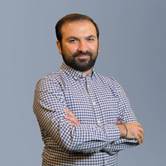
Qais al-Khazaali, secretary general of the Iran-backed Asa’ib Ahl al-Haq paramilitia, speaks to Dhijla TV, November 23, 2019. Photo: Dhijla TV
ERBIL, Kurdistan Region – Only Iraq’s intelligence service can name the “third party” responsible for killing protesters during Iraq’s nationwide protests, Qais al-Khazaali, secretary general of the Iran-backed Asa’ib Ahl al-Haq paramilitia, said Saturday, accusing the US and Israel of provoking the violence.
Protests have raged across central and southern Iraq since October 1 calling for action against corruption, unemployment, and the lack of basic services. Many are now also calling for the overthrow of the political establishment dominated by powerful Shiite parties and militias.
Hundreds of protesters have died and thousands have been injured in clashes with security forces, which have used live ammunition and military grade tear gas to disperse the crowds.
However, eyewitnesses claim masked gunmen operating separately from the Iraqi security forces have also been targeting protesters with lethal force. Many believe these forces have foreign backing.
Asa’ib Ahl al-Haq is a faction within the Popular Mobilization Forces (PMF), known in Arabic as Hashd al-Shaabi. Its fighters were active in the insurgency against the US occupation of Iraq and are fighting in Syria on behalf of the Bashar al-Assad regime.
Groups like Asa’ib Ahl al-Haq are viewed by western policy makers as Iranian proxies.
In an interview with Dhijla TV on Saturday, the group’s commander Khazaali said the committee established by the Iraqi government to investigate the violence is merely an administrative committee, and is unable to identify and expose the “third party” responsible for killing protesters.
“The government report about who is killing the protesters failed to expose the ‘third party’ which is killing the protesters,” Khazaali said. “The committee that that Iraqi PM established is an administrative committee. For that reason they are not capable of discovering who the third party is, as only the intelligence services can expose who the third party is.”
Although Khazaali believes the killings are being perpetrated by locals, he claimed “Israel and US have a great role in the third party”.
The investigation should not be restricted to the question of who killed the protesters but also examine who “eased” the way for the killers and who gave the order to kill the protesters, Khazali said.
Protesters first took to the streets of southern and central Iraq on October 1 to demand action on corruption, high unemployment, and the lack of public services.
Following a pause during the Shiite religious observance of Arbaeen, the protests resumed with fresh demands for a new governing system and the resignation of the president, prime minister, and parliamentary speaker.
At least 320 protesters and members of the security forces have been killed since October 1 and around 15,000 wounded.
On November 16, in an interview with France 24, Iraq’s defense minister, Najah al-Shimari, accused an unspecified “third party” of killing protesters to ignite violence and cause national “instability”.
“The Iraqi national security forces are not the ones killing the protesters,” Shimari said. “There is a third party killing the protesters, to push protesters to clash with security forces to spread instability in Iraq.”
Shimari claimed the military grade tear gas canisters which are being fired directly at the heads of protesters to lethal effect are not the ones purchased or used by Iraq’s official security apparatus.
Khazaali contradicted this claim, insisting the tear gas canisters had in fact been purchased by Iraq’s defense minister.
According to a report published last month by Amnesty International, a significant portion of the tear gas canisters used against the protesters were manufactured by the “Defense Industries Organization (DIO) of Iran”.
Iran’s interference in Iraqi politics and security is very clear, as many factions and senior leaders within the PMF have close historical ties with Tehran, as do many lawmakers inside the Iraqi parliament.
The PMF was created in 2014 following a fatwa, or religious call to action, by Iraq’s highest Shiite religious authority, Ayatollah Ali al-Sistani, in response to the Islamic State (ISIS) insurgency. Although measures have been taken to fully integrate PMF units into Iraq’s military apparatus, many units continue to operate outside the system under the command of Tehran.
Over the course of the protests, many have expressed rage at Iranian interference in Iraqi politics.
Anti-Iran banners have been a regular fixture. Protesters in Baghdad’s Tahrir Square have been seen burning Iranian flags. In Babil they painted the flag on the ground before stomping on it. In Diwaniyah, protesters hit and tore images of Islamic Republic founder Ruhollah Khomeini. In Karbala, protesters attacked the Iranian consulate.
Pro-Iran forces have tried to flip the narrative and accuse the US, Israel, and Saudi Arabia of provoking the unrest in order to weaken the Iran-Iraq relationship. The trading of such accusations comes amid heightened tensions between the US and Iran. There are fears that Iraq, an ally of both Tehran and Washington, could become the site of a proxy war.









Comments
Rudaw moderates all comments submitted on our website. We welcome comments which are relevant to the article and encourage further discussion about the issues that matter to you. We also welcome constructive criticism about Rudaw.
To be approved for publication, however, your comments must meet our community guidelines.
We will not tolerate the following: profanity, threats, personal attacks, vulgarity, abuse (such as sexism, racism, homophobia or xenophobia), or commercial or personal promotion.
Comments that do not meet our guidelines will be rejected. Comments are not edited – they are either approved or rejected.
Post a comment